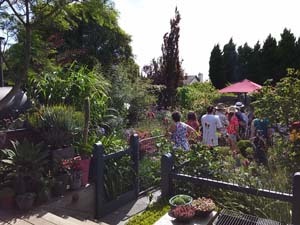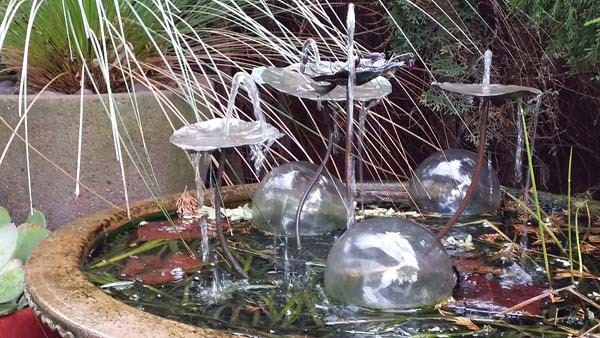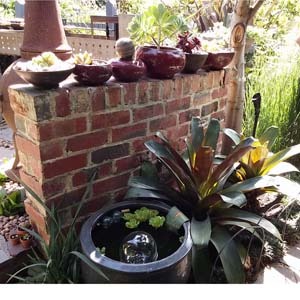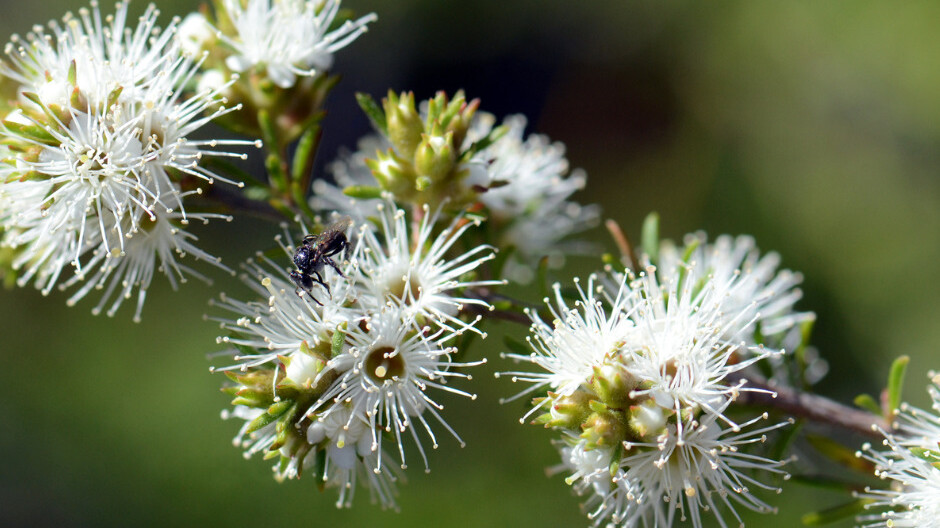A garden created by Sharon and Craig Harris, recently opened to the public in Melbourne as part of SGA’s Open Gardens and Tours program, attracted a large number of visitors. Here we share the description of the garden and the owner’s hints.
Sharon Harris, a landscaper designer, writes:
Our house has a very simple but wonderful history. We are only the second owners, the first were Italian migrants who built it in 1954. From the moment we saw it with its deep back garden, remnant chook shed, several old sheds, fruit trees, wood stove in the kitchen, cellar and extensive original veggie garden -the entire back garden- the potential of 3 Jones Street already existed within the walls and earth of the house. When I entered the front door, passed through the kitchen and saw the amazing stove, I knew this house was meant to be ours, but it wasn’t until I saw the size and layout of the back garden that I started feeling light headed, it was perfect. In that moment I could see the potential of the garden and a hint of the type of life we could have.
That was 18 years ago. The garden has changed over time, but not very much. If anything, it has moved gradually and gracefully towards its full potential as an oasis both visually and productively.
 The fundamental productive and sustainable aspects of our garden have been in place from very early on. We reinstated the original chook shed within the first year, adding a large chook yard. The chooks provide us with eggs but they also provide the compost for the veggie garden and for mulching the rest of the garden. Essentially we get up to 2-3m3 of compost each year. Inside the chook shed we have two 1m x 1m x 1m compost bins. Around three times a year we rake out the chook shed which has been covered with pea straw, or the cut grasses from the nature strip each winter and all the clippings from the winter prune of the perennials in the garden, and fill the compost bins. The mixture of chook poo, carbon material, veggie scraps and cuttings from the garden create amazing, odour-free and friable compost. The design of the compost bin has a lot to do with the healthy development of the compost, with chicken wire in between two compost compartments. This way composting worms can move in between them. The chooks are fantastic pre-cursors to the compost as we throw much of the cut perennials on to the floor of the chook shed and the chooks scratch and sift through them looking for worms, insects etc, essentially starting the breakdown process.
The fundamental productive and sustainable aspects of our garden have been in place from very early on. We reinstated the original chook shed within the first year, adding a large chook yard. The chooks provide us with eggs but they also provide the compost for the veggie garden and for mulching the rest of the garden. Essentially we get up to 2-3m3 of compost each year. Inside the chook shed we have two 1m x 1m x 1m compost bins. Around three times a year we rake out the chook shed which has been covered with pea straw, or the cut grasses from the nature strip each winter and all the clippings from the winter prune of the perennials in the garden, and fill the compost bins. The mixture of chook poo, carbon material, veggie scraps and cuttings from the garden create amazing, odour-free and friable compost. The design of the compost bin has a lot to do with the healthy development of the compost, with chicken wire in between two compost compartments. This way composting worms can move in between them. The chooks are fantastic pre-cursors to the compost as we throw much of the cut perennials on to the floor of the chook shed and the chooks scratch and sift through them looking for worms, insects etc, essentially starting the breakdown process.
 The veggie garden footprint has essentially remained the same since we moved in. There is often a mini battle each year between ornamental plants vs productive plants but the balance usually seems to be just right. The key to a good veggie garden for me is not to overplant any one type of veggie. This obviously depends on the type of vegetable, but by keeping the numbers small and sowing often we have a continual supply of salad vegetables in particular: examples of veggies that require this type of treatment are lettuces, spring onions, rocket, beetroot and radish. Herbs are an integral part of all our meals and in recent years they have started to dominate the tone of the veggie garden. Some herbs such as Thai Basil, Holy Basil, Sweet Basil and Coriander are continually sown during their growing months. Seed is often sown in punnets so that they don’t take up valuable space until ready to be planted out. Most of our veggies and herbs are grown from seed. We grow a variety of unusual herbs such as Perilla, Epazote, Turmeric and Curry Leaves. Many of the herbs such as the Coriander, Perilla and Epazote self seed. Mint is allowed to run riot as it is used heavily and is controlled by being pulled out where it is not wanted and given to the chooks.
The veggie garden footprint has essentially remained the same since we moved in. There is often a mini battle each year between ornamental plants vs productive plants but the balance usually seems to be just right. The key to a good veggie garden for me is not to overplant any one type of veggie. This obviously depends on the type of vegetable, but by keeping the numbers small and sowing often we have a continual supply of salad vegetables in particular: examples of veggies that require this type of treatment are lettuces, spring onions, rocket, beetroot and radish. Herbs are an integral part of all our meals and in recent years they have started to dominate the tone of the veggie garden. Some herbs such as Thai Basil, Holy Basil, Sweet Basil and Coriander are continually sown during their growing months. Seed is often sown in punnets so that they don’t take up valuable space until ready to be planted out. Most of our veggies and herbs are grown from seed. We grow a variety of unusual herbs such as Perilla, Epazote, Turmeric and Curry Leaves. Many of the herbs such as the Coriander, Perilla and Epazote self seed. Mint is allowed to run riot as it is used heavily and is controlled by being pulled out where it is not wanted and given to the chooks.
Fruit, particularly berries and citrus, are a very important part of our productive garden. I have been ruthless in the last couple of years, culling fruit trees that we have had challenges with, such as a wonderfully healthy Tahitian Lime that reliably dropped its fruit every year. Also, a very large fruiting Granny Smith Apple tree that the rats devoured every year no matter the control measure we put in place. I am learning what works for me in the garden, what plants take a lot of time for little gain and I have become more pragmatic about what I will use and what I think I will use. My cooking and the adventures I have with different styles and cuisines ultimately determines what I will and will not plant each season. I have tried galangal and ginger but they did not survive this past winter. Surprisingly the Turmeric does very well in a pot.
Perennial or permanent herb and edible plantings we have in the garden are:
| Herbs Kaffir Lime Curry Leaves Lemon Grass Turmeric Vietnamese Mint Lemon Balm Mint Garlic Chives Chives French Tarragon Rosemary Thyme Lemon Thyme Oregano Marjoram Sage Bay Tree |
Fruit Lemon trees x 2 Pear trees x 2 Youngberry Marionberry Raspberries Thornless Blackberry Strawberries Blueberries Kiwiberry Passionfruit Gooseberry Rhubarb Fig Trees x 2 Fingerlime |
To see other plants that interested people when the garden was open click here.
The most important additions to our garden in recent years are the bees. They have been here for about 18 months and have had a huge impact. This year I have had more raspberries than any other year and the garden overall feels more abundant and healthy. It is literally buzzing with sound. Their very nature is rhythmic and they have created a new and wonderful type of ‘clock’ in the garden. Their response to changes in weather, sun or cloud cover, rain or warmth, time of day, has worked its way into my consciousness and fundamentally affects how I see the garden and the way in which I work in it. Unless the bees are ‘bearding’ on the outside of the hive there only seem to be 20-30 around the outside of the hive at any one time. But in the height of spring and summer there are thousands of bees in the double hive, possibly up to 400,000. The wonderful fragrance of honey pervades the air on warm days.
The water bowls around the garden are utilized by the bees and are an absolute necessity.
Other sustainable aspects to our garden are:
- The three sets of water tanks totaling 13,000 litres.
- The entire house is covered in either the Ornamental Grape or Virginia Creeper. This means that the sun does not hit any of the walls and this fundamentally affects the temperature in the house. Conversely the windows in the back room allow all the winter sun into the house, as the vines are deciduous.
- We have a wood fire for heating and use a mixture of sustainably grown sugar gum and red gum, with the potash from the fire used to de-louse the chooks, add potash to the compost and/or garden to encourage flowering.
- The prunings from the loosely pleached Ornamental Pears in the driveway are kept and dried for use in the fire. There are solar panels on the roof.
 We live simply in a small house in suburbia but our garden provides us with a richness and earthiness that allows us to enjoy living simply but abundantly.
We live simply in a small house in suburbia but our garden provides us with a richness and earthiness that allows us to enjoy living simply but abundantly.
An SGA observation
An outstanding feature is the very large collection of low-water-requiring succulents in pots along the drive way, around the barbecue and along the outdoor deck. Such variety in colours and shapes!
Related Articles:
Wildflower gardens – What’s the buzz about?
In the quest for sustainable and environmentally conscious practices, gardening enthusiasts and nature lovers alike are turning to a time-tested…
Garden Journaling – Slow down to tune in.
As we move through the year and our gardens evolve, there's something magical about documenting the journey. Garden journaling is an art that enables…




